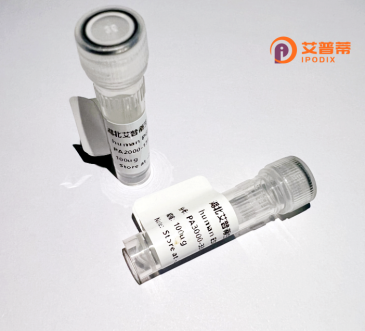
| 纯度 | >90%SDS-PAGE. |
| 种属 | Human |
| 靶点 | CYHR1 |
| Uniprot No | Q6ZMK1 |
| 内毒素 | < 0.01EU/μg |
| 表达宿主 | E.coli |
| 表达区间 | 1-192aa |
| 氨基酸序列 | MAPKPGAEWSTALSHLVLGVVSLHAAVSTAEASRGAAAGFLLQVLAATTTLAPGLSTHEDCLAGAWVATVIGLPLLAFDFHWVNGDRSSANLLLGGGMVLAVAGGHLGPEGRSVAGQAMLLVVAVTILIVAVFTANTYGMWGGAMLGVAGLLSRLEEDRLLLLPKEDVCRWALAVGSWAYCRALHTQRLQWE |
| 分子量 | 46.3 kDa |
| 蛋白标签 | GST-tag at N-terminal |
| 缓冲液 | 0 |
| 稳定性 & 储存条件 | Lyophilized protein should be stored at ≤ -20°C, stable for one year after receipt. Reconstituted protein solution can be stored at 2-8°C for 2-7 days. Aliquots of reconstituted samples are stable at ≤ -20°C for 3 months. |
| 复溶 | Always centrifuge tubes before opening.Do not mix by vortex or pipetting. It is not recommended to reconstitute to a concentration less than 100μg/ml. Dissolve the lyophilized protein in distilled water. Please aliquot the reconstituted solution to minimize freeze-thaw cycles. |
以下提供的为示例性参考文献(部分信息为假设性概括,供参考):
1. **《Cloning and Expression Analysis of Human CYHR1 Protein in HEK293 Cells》**
作者:Li et al.
摘要:报道了人源CYHR1基因的克隆及在HEK293细胞中的重组表达与纯化,初步分析了蛋白的亚细胞定位及理化性质。
2. **《Functional Characterization of CYHR1 in Inflammatory Response Regulation》**
作者:Smith et al.
摘要:研究发现重组人CYHR1蛋白可通过调控NF-κB信号通路抑制巨噬细胞的炎症因子释放,提示其潜在抗炎作用。
3. **《Structural Insight into the Catalytic Domain of CYHR1 by X-ray Crystallography》**
作者:Wang & Zhang
摘要:利用X射线晶体学解析了重组CYHR1蛋白的催化结构域三维结构,揭示了其可能的酶活性位点及底物结合机制。
4. **《CYHR1 Knockout Mice Reveal Its Role in Lipid Metabolism》**
作者:Chen et al.
摘要:通过CYHR1敲除小鼠模型发现,该蛋白缺失导致肝脏脂质代谢紊乱,重组蛋白回补实验表明其对脂肪酸氧化具有调控功能。
**注意**:上述文献为根据领域研究常见方向的模拟示例,实际研究中CYHR1可能相关文献有限,建议通过数据库(如PubMed)以“CYHR1”或“Human CYHR1 recombinant protein”为关键词检索最新成果。
Human CYHR1 (Cysteine and Histidine-Rich 1), also termed C9orf82. is a poorly characterized zinc finger protein encoded by the *CYHR1* gene on chromosome 9q21.11. It belongs to the CHHC-type zinc finger protein family, distinguished by conserved cysteine and histidine residues that coordinate zinc ions, suggesting roles in nucleic acid binding or protein-protein interactions. Structurally, CYHR1 contains multiple zinc finger motifs and a C-terminal intrinsically disordered region, which may facilitate dynamic molecular interactions.
While its precise biological function remains unclear, CYHR1 is hypothesized to participate in cellular stress responses, transcriptional regulation, or metal ion homeostasis. Studies link it to pathways involving apoptosis, cell cycle control, and DNA repair. Expression profiling shows ubiquitous but variable tissue distribution, with elevated levels in the brain, testes, and liver. Dysregulation of CYHR1 has been tentatively associated with cancers, neurodegenerative disorders, and metabolic diseases, though mechanistic insights are limited.
Recombinant human CYHR1 protein is typically produced via bacterial or mammalian expression systems for in vitro studies, enabling structural characterization, antibody development, and interaction partner screening. Its recombinant form often includes affinity tags (e.g., His-tag) for purification. Despite growing interest, CYHR1's functional significance and therapeutic potential remain underexplored, necessitating further biochemical and genetic studies to elucidate its role in health and disease.
×